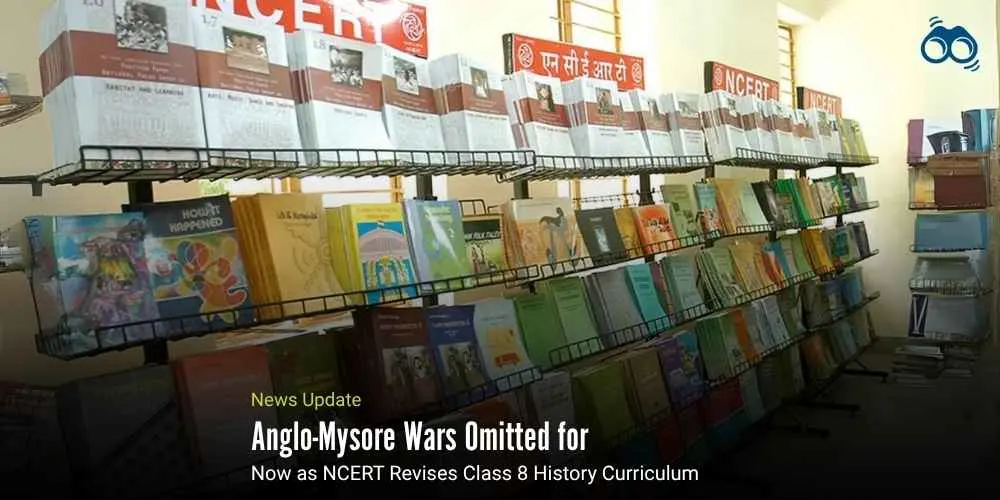NCERT Shifts Focus from Resistance to Colonial Economics in Revised Curriculum
Tipu Sultan and Anglo-Mysore Wars Excluded from New Class 8 History Textbook
For decades, NCERT history textbooks have shaped how Indian students understand their national past. Earlier editions, particularly those used during the 2000s and 2010s, offered a broad account of India’s history, emphasising diverse resistance movements, regional powers, and socio-political complexities. Figures such as Tipu Sultan, Haidar Ali, and the Anglo-Mysore wars were prominently featured as central actors in resisting British colonial expansion, especially in southern India.
However, the newly released Class 8 Social Science textbook (2025), titled Exploring Society: India and Beyond, marks a notable departure from this approach. While it retains coverage of key events such as Vasco da Gama’s arrival, the Battle of Plassey (1757), and the Great Indian Rebellion (1857), it omits references to Tipu Sultan and the Anglo-Mysore wars, once considered essential to the narrative of colonial resistance. This omission has prompted concern among educators and historians, who argue that it reflects a selective framing of India’s colonial history and risks erasing significant figures from the resistance discourse.
The revised textbook outlines the British transition from traders to rulers, focusing on the economic consequences of colonial rule, particularly the “drain of India’s wealth.” It includes early uprisings such as the Sannyasi-Fakir Rebellion, the Kol and Santhal movements, and various 19th-century peasant revolts. A chapter on the Marathas asserts that British control over India was gained more from them than from the Mughals. Nevertheless, the absence of Tipu Sultan and Haidar Ali, who mounted sustained military resistance against British expansion, has raised questions about the completeness of the narrative.
In contrast to the current edition, earlier Class 8 textbooks detailed the East India Company’s expansion from 1757 to 1857, highlighting the role of Mysore under Haidar Ali and Tipu Sultan, the four Anglo-Mysore wars, and conflicts with the Marathas. When asked whether these topics would appear in Part 2 of the new textbook, NCERT committee chair Michel Danino indicated that the chapters were still under development. He later clarified that Tipu Sultan and the Anglo-Mysore wars were unlikely to be included, citing the need to avoid overloading middle school content with historical detail. According to Danino, Classes 6 to 8 are intended to provide a broad overview, with more in-depth coverage reserved for Classes 9 to 12.
The textbook describes the colonial era as a period of European expansion beginning in the 15th century, noting that while colonisers claimed a “civilising mission,” their actions often led to the destruction of traditional ways of life and the imposition of foreign cultural values. It also highlights India’s economic strength before colonial rule, stating that the country contributed nearly a quarter of the world’s GDP until the 16th century, alongside China. Under British rule, however, India’s share declined sharply to around 5% by independence. The book attributes this decline to the “drain of wealth,” citing economist Utsa Patnaik’s estimate that colonisers extracted approximately $45 trillion (in today’s value) between 1765 and 1938. It suggests that had this wealth remained in India, the country’s post-independence condition would have been significantly different.
Furthermore, the textbook challenges the notion that infrastructure such as railways and telegraph systems was a gift from the British. It asserts that these were largely funded by Indian taxpayers and served British commercial and strategic interests. It also draws attention to the colonial plunder of Indian cultural artefacts, including statues, paintings, jewels, and manuscripts, which were sent to European museums and private collections. This is described as part of a broader pattern of “massive theft” across colonised regions, a perspective not included in previous editions.
Michel Danino reportedly stated that the textbook’s inclusion of details on the funding of railways, the telegraph system, and wars such as the suppression of the 1857 Rebellion was intended to dispel the misconception that these were benevolent contributions by colonial powers. He emphasised that these developments were financed primarily through Indian tax revenues, which placed a heavy burden on the population, particularly peasants. He also clarified that these remarks reflected his personal views. This evolving portrayal of colonial history in NCERT textbooks underscores the need for a balanced curriculum that neither simplifies resistance narratives nor overlooks the complexities of India’s past.
Editor’s Note:
The recent revisions to the NCERT Class 8 Social Science textbook have prompted significant reflection on how history is presented to young learners. While the new edition places considerable emphasis on the economic impact of British rule, highlighting the drain of India’s wealth and the use of Indian tax revenue to fund colonial infrastructure, it notably omits key figures such as Tipu Sultan and Haidar Ali, who played crucial roles in resisting British expansion in southern India. Tipu Sultan, often remembered as the “Tiger of Mysore,” was not only a military strategist but also a prominent symbol of early anti-colonial resistance. His exclusion from this foundational stage of historical education risks depriving students of a fuller understanding of the diverse and regionally rooted struggles against imperialism. The resistance led by Mysore was not merely a regional episode; it formed a vital part of India’s broader fight against colonial domination. There is no doubt that educating students about the economic exploitation under British rule is essential. However, omitting stories of bravery, sacrifice, and resistance from figures such as Tipu Sultan presents an incomplete and potentially unbalanced picture of India’s past. The Anglo-Mysore Wars and Tipu Sultan’s leadership were significant in shaping the early contours of colonial conflict in India.
Skoobuzz contends that history education must strike a thoughtful balance, one that incorporates factual accuracy, diverse perspectives, and voices from all regions of the country. Excluding such figures may inadvertently narrow students’ understanding of the complexity and pluralism of India’s freedom struggle. Textbooks must capture not only what was lost under colonialism but also how Indians across the subcontinent actively resisted that loss. Only then can students truly appreciate the richness and resilience of their heritage.














0 Comments (Please Login To Continue)